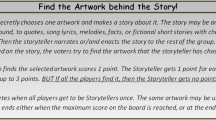Abstract
Object-based learning includes the active incorporation of historic artifacts into educational environments, which may yield meaningful learning experiences. However, gaining access to artifacts and coordinating object-based curricula with museum staff pose immense challenges to educators. Furthermore, digital representations of historic artifacts are often removed from authentic, culturally-situated surroundings. By providing a system-level overview of a game currently under development titled Kresy, this emerging technology report explains how video game affordances, particularly interactive narrative, may support object-based learning in digital environments. To support object-based learning and engagement with 20th-century Eastern European history, Kresy weaves story through evidence collection and inquiry mechanics. In presenting these design considerations, this report shows the viability of merging game- and object-based learning within an immersive virtual environment.






Similar content being viewed by others
Data Availability
No data accompanies this conceptual article.
References
Ludography
Barab, S. A., Pettyjohn, P., Gresalfi, M., Volk, C., & Solomou, M. (2012). Game-based curriculum and transformational play: Designing to meaningfully positioning person, content, and context. Computers & Education, 58(1), 518–533. https://doi.org/10.1016/j.compedu.2011.08.001
Benjamin, W. (1968). The work of art in the age of mechanical reproduction. In H. Arendt (Ed.), Illuminations (pp. 217–252). Schocken Books.
Berlyne, D. E. (1960). Conflict, arousal and curiosity. McGraw-Hill.
Brown, K. (2005). A biography of no place: From ethnic borderland to Soviet heartland. Harvard University Press.
Bruner, J. S. (1990). Acts of meaning. Harvard University Press.
Cameron, C. A., & Gatewood, J. B. (2003). Seeking numinous experiences in the unremembered past. Ethnology, 42(1), 55–71. https://doi.org/10.2307/3773809
Champion, E. (2011). Playing with the past. Springer.
Chatterjee, H. J., Hannan, L., & Thomson, L. (2015). An introduction to object-based learning and multisensory engagement”. In H. J. Chatterjee & L. Hannan (Eds.), Engaging the senses: Object-based learning in higher education (pp. 1–18). Ashgate.
Chatterjee, H. J., MacDonald, S., Prytherch, D., & Noble, G. (Eds.). (2008). Touch in museums: Policy and practice in object handling. Berg.
Csikszentmihalyi, M., & Rochberg-Halton, E. (1981). The meaning of things: Domestic symbols and the self. Cambridge University Press.
Deci, E. L., & Ryan, R. M. (2000). The “what” and “why” of goal pursuits: Human needs and the self-determination of behavior. Psychological Inquiry, 11, 227–268. https://doi.org/10.1207/S15327965PLI1104_01
Dierking, L. D. (2002). The role of context in children’s learning from objects and experiences. In S. G. Paris (Ed.), Perspective on object-centered learning in museums (pp. 3–16). Lawrence Erlbaum Associates.
Falk, J. H., & Dierking, L. D. (2000). Learning from museums: Visitor experiences and the making of meaning. AltaMira Press.
Green, M. C. (2004). Storytelling in Teaching. Association for Psychological Science. https://www.psychologicalscience.org/observer/storytelling-in-teaching
Greenblatt, S. (1991). Resonance and wonder. In I. Karp & S. D. Lavine (Eds.), Exhibiting cultures: The poetics and politics of museum display (pp. 42–56). Smithsonian Institution Press.
Jeffrey, S. (2015). Challenging heritage visualisation: Beauty, aura and democratisation. Open Archaeology. https://doi.org/10.1515/opar-2015-0008
Jenkins, H. (2004). Game design as narrative architecture. In N. Wardrip-Fruin & P. Harrigan (Eds.), First person (pp. 118–130). MIT Press.
Kidd, J. (2015). Gaming for affect: Museum online games and the embrace of empathy. Journal of Curatorial Studies, 4(3), 414–432. https://doi.org/10.1386/jcs.4.3.414_1
Kolb, D. A. (1984). Experiential learning: Experience as the source of learning and development. Prentice Hall.
Krause, F. L., Israel, J. H., Neumann, J., & Feldmann-Wüstefeld, T. (2007). Usability of hybrid, physical and virtual objects for basic manipulation tasks in virtual environments. In IEEE Symposium on 3D User Interfaces 2007 - Proceedings, 3DUI 2007, 87–94. https://doi.org/10.1109/3DUI.2007.340779
Latham, K. F. (2013). Numinous experiences with museum objects. Visitor Studies, 16(1), 3–20. https://doi.org/10.1080/10645578.2013.767728
McCall, J. (2013). Gaming the past: Using video games to teach secondary history. Routledge.
Nahl, D. (2010). Affective load and engagement in Second Life. International Journal of Virtual and Personal Learning Environments, 1(3), 1–16. https://doi.org/10.4018/jvple.2010070101
Phares, E. J. (1976). Locus of control in personality. General Learning Press.
Poupyrev, I., Ichikawa, T., Weghorst, S., & Billinghurst, M. (1998). Egocentric object manipulation in virtual environments: Empirical evaluation of interaction techniques. Computer Graphics Forum, 17(3), 41–52. https://doi.org/10.1111/1467-8659.00252
Rounds, J. (2004). Strategies for the curiosity-driven museum visitor. Curator, 47(4), 389–412. https://doi.org/10.1111/j.2151-6952.2004.tb00135.x
Ryan, M.-L. (2008). Interactive narrative, plot types, and interpersonal relations. In U. Spierling & N. Szilas (Eds.), Interactive storytelling (pp. 6–13). Springer. https://doi.org/10.1007/978-3-540-89454-4_2
Ryan, R. M., Rigby, C. S., & Przybylski, A. (2006). The motivational pull of video games: A self-determination theory approach. Motivation and Emotion, 30(4), 347–363. https://doi.org/10.1007/s11031-006-9051-8
Stack, M. D. L. (2021). Removing impediments to game-based learning in Southern African history classrooms through Napoleon Total War [Master’s thesis, Stellenbosch University]. http://scholar.sun.ac.za/handle/10019.1/123946
Tiballi, A. (2015). Engaging the past: Haptics and object-based learning in multiple dimensions. In H. J. Chatterjee & L. Hannan (Eds.), Engaging the senses: Object-based learning in higher education (pp. 76–91). Ashgate.
Urban, A. C. (2020). Narrative ephemera: Documents in storytelling worlds. Journal of Documentation. https://doi.org/10.1108/JD-04-2020-0058
Woodall, A. (2015). Rummaging as a strategy for creative thinking and imaginative engagement in higher education. In H. J. Chatterjee & L. Hannan (Eds.), Engaging the senses: Object-based learning in higher education (pp. 133–154). Ashgate.
Assassin’s Creed: Odyssey: Discovery Tour [Video game]. (2019). Ubisoft.
Civilization [Video Game]. (1991). MicroProse.
Elder scrolls V: Skyrim [Video game]. (2011). Bethesda Softworks.
Gone Home [Video game]. (2013). The Fullbright Company.
Papers, please [Video game]. (2016). Campo Santo.
SimCity [Video game]. (1989). Maxis.
Funding
No funding was received to assist with the preparation of this manuscript.
Author information
Authors and Affiliations
Corresponding author
Ethics declarations
Competing interests
The authors have no competing interests to declare that are relevant to the content of this article.
Additional information
Publisher's Note
Springer Nature remains neutral with regard to jurisdictional claims in published maps and institutional affiliations.
Rights and permissions
About this article
Cite this article
Urban, A. Interactive Artifacts and Stories: Design Considerations for an Object-Based Learning History Game. Tech Know Learn 28, 1803–1813 (2023). https://doi.org/10.1007/s10758-023-09653-x
Accepted:
Published:
Issue Date:
DOI: https://doi.org/10.1007/s10758-023-09653-x




